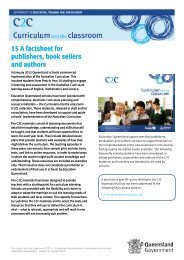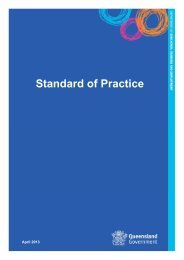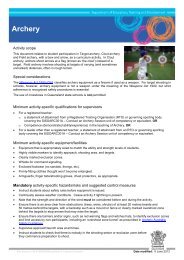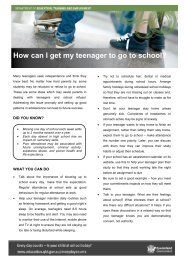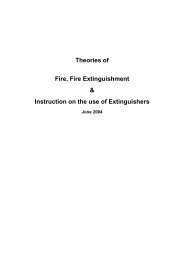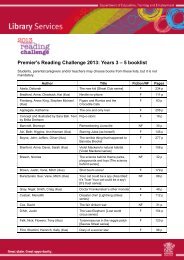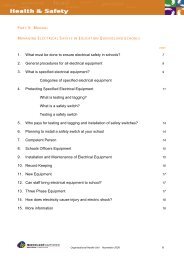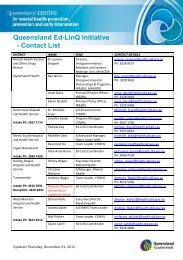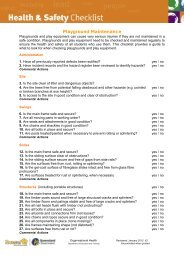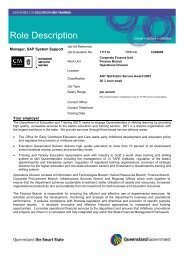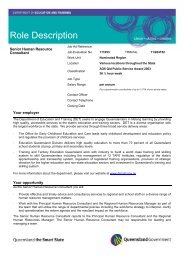Anaphylaxis guidelines for Queensland State Schools - Education ...
Anaphylaxis guidelines for Queensland State Schools - Education ...
Anaphylaxis guidelines for Queensland State Schools - Education ...
Create successful ePaper yourself
Turn your PDF publications into a flip-book with our unique Google optimized e-Paper software.
8.3 Developing a school emergency response procedure<br />
• Refer to Section 7 of these Guidelines to plan <strong>for</strong> an emergency event and develop a school-based<br />
emergency treatment procedure as part of the school’s <strong>Anaphylaxis</strong> Risk Management Plan.<br />
• Ensure all staff are aware of the school procedure <strong>for</strong> alerting other personnel to an anaphylactic<br />
emergency and need <strong>for</strong> assistance (e.g. mobile phone, walkie talkies, classroom phones).<br />
• Determine an agreed storage location <strong>for</strong> school and students’ auto-injector/s and ensure all staff are<br />
aware of these locations.<br />
• In<strong>for</strong>m staff that the first line emergency response will be with the student’s own labelled adrenaline<br />
auto-injector, and that the school’s adrenaline auto-injector <strong>for</strong> ‘general use’ is to be administered if<br />
there is no response after five minutes or as indicated on the student’s Action Plan or as a back-up in<br />
the event of a misfire.<br />
• In<strong>for</strong>m staff that the school’s adrenaline auto-injector may also be required if a previously undiagnosed<br />
student demonstrates a first time anaphylactic reaction.<br />
9. Roles and responsibilities of the teacher<br />
To assist the school in supporting students with severe allergies or anaphylaxis, teachers who provide any<br />
supervisory role are advised to:<br />
Know the student and their condition<br />
• Ensure you can recognise by sight the students who are at risk of anaphylaxis.<br />
• Read and become familiar with students’ Action Plans.<br />
Know what to do in an emergency<br />
• Ensure you are familiar with the school’s emergency procedures <strong>for</strong><br />
students with and without an Action Plan.<br />
• Ensure the school’s emergency procedure is operational <strong>for</strong> the students<br />
you supervise or discuss issues with the principal to determine workable<br />
solutions.<br />
• Know who is trained to administer the adrenaline auto-injector or complete<br />
the required training.<br />
• Ensure you know where the school’s adrenaline auto-injector is stored.<br />
Complete training<br />
• Complete the Australasian Society of Clinical Immunology and Allergy<br />
(ASCIA) anaphylaxis e-learning course to gain a certificate of completion.<br />
Complete practical training in using an adrenaline auto-injector after you have completed online training.<br />
Implement risk management procedures<br />
• Ensure the student’s anaphylaxis emergency kit (which includes their adrenaline auto-injector) is:<br />
- stored in a cool, dark location but not refrigerated<br />
- readily accessible at all times (e.g., not locked in a cupboard or room)<br />
Example of student<br />
Action Plan<br />
(template)<br />
- stored in a location known to all supervisory staff (this will vary according to the activity)<br />
- taken with student to all locations including specialist classes, extracurricular activities on the<br />
school grounds outside normal school hours and activities off campus that are outside school<br />
hours.<br />
23 <strong>Anaphylaxis</strong> <strong>guidelines</strong> <strong>for</strong> <strong>Queensland</strong> state schools



